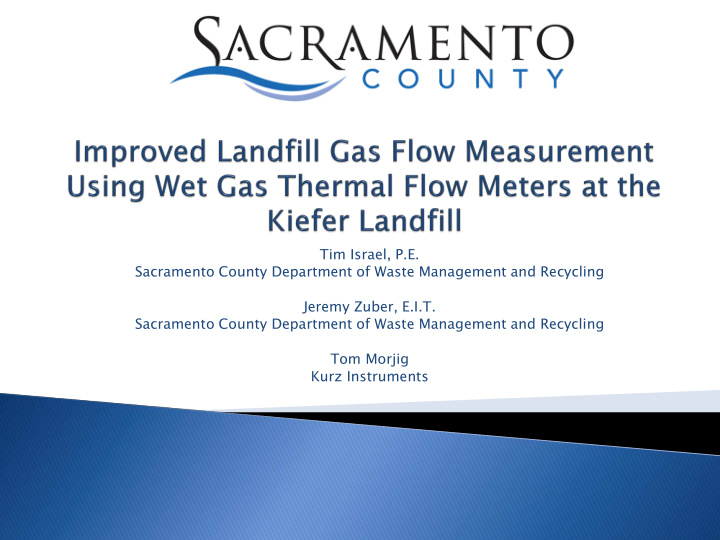



Tim Israel, P.E. Sacramento County Department of Waste Management and Recycling Jeremy Zuber, E.I.T. Sacramento County Department of Waste Management and Recycling Tom Morjig Kurz Instruments
Drivers Flow Meter Basics Biogas Flow Metering Issues Flow Meter Types Kiefer Landfill Use of Wet Gas Meters at Kiefer Conclusions
Federal GHG Inventory State Inventory Local Permit Metering Requirements Energy Project Development Air District Fees and Title V designation
Variable Flows ◦ Flares are designed with up to a 10:1 turndown Variable Quality ◦ CH 4 Quality can range from 30% to 50% ◦ 2% change in CH 4 translates into 1% flow error Saturated Gas ◦ Big impact on mass flow measurements Dirty Conditions ◦ Affects the accuracy of the measuring device
Requires Mass Flow Measurement High Turndown Can Operate in Dirty Environments Low O&M Cost
Differential Pressure (Orifice e Plates, es, Pitot t Tubes, s, Venturis ris) Thermal Turbine Vortex Ultrasonic Coriolis
Typically an Orifice Plate Type Consists of an orifice in a straight length of pipe which creates a pressure drop Static pressure, density, temperature and differential pressure are measured Measures Volume Easy to field-service and have no moving parts Issues: Poor flow turn down, poor tolerance to water and dirt, higher operational cost due to large pressure drop
Orifice Plate dP P T
Measures the Heat Transfer From a Heated Probe to the Flowing Gas Easy to Install Minimal Obstructions and No Moving Parts ◦ Dirt tends to blow past sensor ◦ Ideal for dry gas flow measurements Directly Reads Mass Flow Accuracy Reduced in Wet Conditions (high reads) ◦ Thermal sensor will read false high from varying water moisture levels entrained in the gas flow.
Heated Sensor 5 to 75 °C above process T Process T sensor
Owned and Operated by Sacramento County Part of the County’s Vertically Integrated System Opened in 1967 Approximately 30,000,000 Tons of Refuse in place History of LFG Migration and Groundwater Impacts Aggressive LFG Collection and Control
LFG Migration Discovered in Early 90s High Concentrations Found over 2,000 Feet From Footprint Original System Began Operation in 1997 Flare Station and 15 Megawatt Power Plant LFG Collection Both Internally and on Perimeter Current Flowrate of 7,000 SCFM Remnants of Original LFG “Cloud” Remain
Achieve Full Backup Capacity In Case of Energy Plant Shutdown Added Second Flare Upgraded Controls and Added VFDs New Standard Thermal Flow Meters for Energy Plant Intakes and New Flare
Energy Plant Meters Reading Inconsistent ~20% High Spikes in Readings Attributed to Condensing Gas on Probe
Kurz Replaced Standard Meter With Their Wet Gas Meter (WGF) 300 °C Overheat Thermal Meter Eliminated the Condensing Gas Issue Wider sensor stings to avoid water bridging Capable of reporting wet and dry gas flowrates ( rates tes with h or w without out H 2 O gas contribut ributio ion ) Accuracy Verified Through Onsite Field Calibration
Heated Sensor 300 °C above process T Process T sensor
Accurate Flow Meter is Critical for Both Regulatory and Project Development Wide Variety of Meters that Can be Used Your Specific Conditions Will Drive Meter Selection
Recommend
More recommend